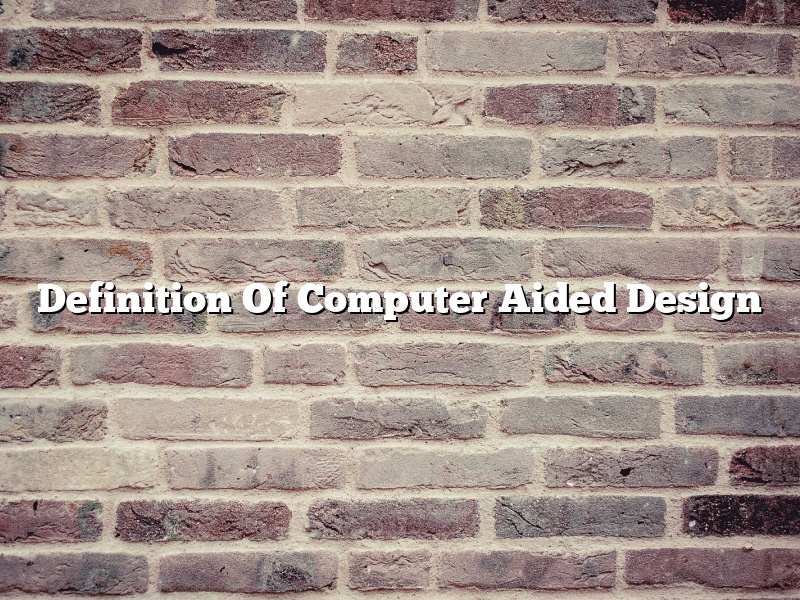Computer-aided design (CAD) is the use of computer systems to assist in the creation, modification, analysis, or optimization of a design. CAD software is used to increase the productivity of the designer, improve the quality of design, and enable the sharing and reuse of design data.
Computer-aided design has been used in a wide range of industries, including automotive, aerospace, and shipbuilding, as well as in the design of furniture, clothing, and jewelry. The first CAD system was developed in the early 1960s, and CAD technology has continued to evolve since then.
There are many different types of CAD software, and the features and capabilities of each package vary. However, most CAD software packages share some common features, including the ability to create and edit 3D models, the ability to create and edit 2D drawings, and the ability to annotate designs with dimensions and other information.
CAD software can be used to create models of existing objects, to create new objects from scratch, or to modify existing objects. When creating a new object, the user typically starts by creating a 3D model of the object. The 3D model can be created from scratch, or it can be based on a scanned or photographed object.
Once the 3D model is created, the user can then create a 2D drawing of the object. The 2D drawing can be used to generate a blueprint or plan view of the object. The user can also use the 2D drawing to create manufacturing drawings, which show the dimensions and other information needed to manufacture the object.
In addition to creating 2D and 3D drawings, CAD software can also be used to generate manufacturing information. This information can include data on the shape and size of the object, the type and thickness of the material that will be used to manufacture the object, and the number and location of the fasteners that will be used to assemble the object.
CAD software can also be used to create animations and simulations of how the object will be used. This can be helpful in determining how the object will behave under different conditions.
CAD software is used by both professionals and hobbyists. Professionals use CAD software to create designs for a wide range of products, including cars, airplanes, and buildings. Hobbyists use CAD software to create models of objects that they can then print using a 3D printer.
CAD software is available in a variety of different formats, including desktop software, online software, and mobile apps. Desktop software is installed on a computer and is typically used by professionals. Online software is accessed through a web browser and is typically used by hobbyists. Mobile apps are installed on a mobile device and are typically used by professionals and hobbyists who need to be able to access their designs while away from their computer.
CAD software is a powerful tool that can be used to create a wide range of designs. It is used by professionals and hobbyists to create everything from simple drawings to complex 3D models.
Contents [hide]
What is meaning of computer-aided design?
Computer-aided design (CAD) is a process of designing products with the help of computer software. It started gaining popularity in the early 1980s, and has since become an essential tool in many industries.
There are many different types of CAD software, each with its own set of features. Some software is specifically designed for engineering or architectural projects, while others are more general-purpose and can be used for a variety of tasks.
CAD software can be used to create 2D or 3D models of products. It can also be used to generate technical drawings, illustrations, and schematics. In many cases, CAD files can be used to generate CNC machining instructions or 3D printing models.
CAD is a very versatile tool and can be used for a wide range of purposes. It is often used to create prototypes, test new designs, and communicate with manufacturers. CAD files can also be used to create marketing materials and product manuals.
CAD is a very powerful tool, and with the right training it can be used to create anything from a simple sketch to a complex 3D model. It is a popular tool among engineers, architects, and product designers, but can be used by anyone who needs to create or modify digital designs.
What is computer-aided design with examples?
Computer-aided design (CAD) is the use of computer technology to aid in the design and development of products. CAD software allows engineers and designers to create and edit digital models of objects or systems.
There are many different types of CAD software, each with its own set of tools and capabilities. Some software is designed for specific industries, such as architecture or engineering. Others are more general-purpose, and can be used for a variety of purposes.
CAD software can be used to create 2D or 3D models. 2D models are used for simple objects, such as logos or illustrations. 3D models are used for more complex objects, such as cars or buildings.
3D models can be used to create both physical and digital prototypes. Physical prototypes are used to test the feasibility of a design and to get feedback from users. Digital prototypes are used to test the feasibility of a design and to get feedback from users.
CAD software can also be used to create manufacturing drawings. Manufacturing drawings are used to create instructions for manufacturing a product.
CAD software is widely used in the engineering and design industries. It can be used to create products of all shapes and sizes, from simple objects to complex systems.
What is CAD and its benefits?
What is CAD and What are its benefits?
CAD is an acronym for “Computer Aided Design.” CAD software is used to create or modify designs for products or structures. It is used in a wide range of industries, including architecture, engineering, and manufacturing.
There are many benefits to using CAD software. Some of the most notable benefits include:
1. Increased accuracy and efficiency.
2. Reduced development time and costs.
3. Easier collaboration between team members.
4. Greater flexibility to make changes.
5. Increased creativity and innovation.
6. Improved communication of design ideas.
7. Reduced manufacturing defects.
8. Reduced environmental impact.
9. Increased competitiveness.
10. Improved quality of life.
Overall, CAD software provides a number of advantages that can help businesses and individuals be more efficient and productive. It can also help to improve the quality of products and services, as well as reduce environmental impact.
What does CAD mean in engineering?
Computer-aided design (CAD) is a process of using computer software to create or design a three-dimensional (3D) object. CAD software allows engineers and designers to create digital representations of their ideas.
CAD is commonly used in engineering and product design. It allows engineers to create models of their products, which can then be used to test the products’ functionality and feasibility.
CAD software can be used to create a variety of objects, including parts, assemblies, and complete products. It can also be used to create 2D drawings of objects.
CAD software is widely used in the manufacturing and engineering industries. It can help engineers and designers speed up the design process, and it can also help them create more accurate and detailed designs.
What are the features of CAD?
Computer-aided design (CAD) is the use of computer technology to aid in the creation, modification, analysis, or optimization of a design. CAD software is used to design objects, including 3D models, 2D drawings, and schematics.
CAD has been used extensively in many industries, including architecture, engineering, and manufacturing. It can be used to design a wide range of objects, including buildings, furniture, and automobiles.
CAD software can be used to create 2D drawings or 3D models. 3D models can be used to create a physical representation of an object, or they can be used to create a virtual image of the object.
CAD software can be used to create a variety of different types of drawings, including orthographic projections, isometric projections, and section drawings.
CAD software can be used to optimize designs for manufacturability. It can also be used to create models for analysis, such as stress analysis or thermal analysis.
CAD software is often used in conjunction with other software, such as computer-aided manufacturing (CAM) software or computer-aided engineering (CAE) software.
How many types of CAD are there?
There are a few different types of CAD software out there on the market. Here is a breakdown of the most popular types of CAD software:
2D CAD software is used to create two-dimensional drawings, typically used in engineering and architecture.
3D CAD software is used to create three-dimensional models, often used in product design and manufacturing.
parametric CAD software is used to create models that can be easily modified, often used in engineering.
non-parametric CAD software is used to create models that are not easily modified, often used in architecture and design.
Computer-Aided Manufacturing (CAM) software is used to create tool paths for manufacturing products using 3D CAD models.
There are a variety of different CAD software packages on the market, each with their own strengths and weaknesses. It is important to choose the CAD software that is best suited for the task at hand.
What are the 5 advantages of CAD?
Computer-aided design (CAD) is a process of designing products or parts with the help of a computer. It offers a number of advantages over traditional methods.
1. Increased Efficiency
CAD allows designers to create and modify designs much more quickly and easily than with traditional methods. This leads to increased efficiency and higher quality products.
2. Increased Accuracy
CAD allows for greater accuracy in design, leading to fewer mistakes and problems in the manufacturing process.
3. Increased Flexibility
CAD allows for greater flexibility in design, making it possible to change and adapt designs more easily.
4. Reduced Costs
CAD can help reduce costs by allowing designers to work more efficiently and accurately.
5. Greater Design Options
CAD offers designers a greater range of design options, making it possible to create more innovative and efficient products.




